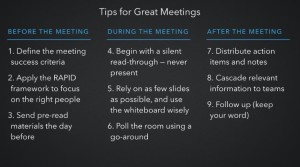Powerful and meaningful messaging isn’t just for communication to those outside of your organization. Equally important are the conversations and dialogues you have with your own staff, board of directors, and volunteers. And in no place is this more crucial than in how you conduct meetings.
Here are three ideas we’ve found to be exceptionally helpful in maximizing your meeting efficacy and building better relationships with your teams.
Brainwriting
How many times have you been in a meeting where it seems like one person is dominating the conversation? Where all ideas seem to be coming from the loudest in the room? Leigh Thompson, professor at the Kellogg School of Management, suggests a new concept when brainstorming ideas – brainwriting.
Brainwriting is simply giving everyone a little quiet time to gather their own ideas before jumping to collaboration.
By writing down ideas before discussion starts, and by having anonymity enforced in reviewing ideas, you can have a more productive conversation around improvements to your organization’s strategy.
Objective Focused
LinkedIn recently received some feedback after posting their tips to successful meetings. Were so many steps really necessary to ensure a productive meeting?

To be honest – yes and no. If your organization is habitually disorganized and ineffective when meeting in groups, then it makes sense to add a more regimented structure to your meeting agendas and implementation. But regardless of how successful communication is within your meetings, one key component of this list stands out – defining the meeting success criteria.
Put more simply, announce why you are meeting. Whether it is making a decision for an event, deciding to shift strategies, or agreeing on who will reach out to a specific volunteer, before the meeting starts, identify and communicate with the larger group the goal of the meeting. By explicitly labeling the purpose, you will have greater engagement and focus from the rest of your team.
Limiting Size
Finally, the CEO of New Relic made waves recently when he announced that if the meeting has more than six people in it, he won’t go. Why six? He believes that six is the right amount to continue an open dialogue – otherwise you are just receiving information, and odds are, this information likely could have been distributed in a more time effective manner than having a large meeting.
Consider it this way – when at a large dinner party, what is the size of a table where people talk and converse with the whole table, without breaking off into smaller sub groups? Or without one person dominating the story telling? The same communication patterns appear in meetings. By limiting the size of the group, you will have a better opportunity to solve problems and create positive outcomes.
If this blog post didn’t meet your expectations, hopefully these links will quench your nonprofit communication and strategy thirst:
- Pam Fessler of NPR discusses the changing dynamics of peer-to-peer fundraising on All Things Considered.
- Struggling to raise money from foundations? Marilyn Hoyt of the Foundation Center shares five strategies to streamline your approach to foundations.
- Rob Roy of Adobe highlights the need for responsive design as mobile usage continues to skyrocket.
- Charity Navigator is looking for a new leadership after President and CEO Ken Berger stepped down. Paul Clolery of the NonProfit Times provides the details.